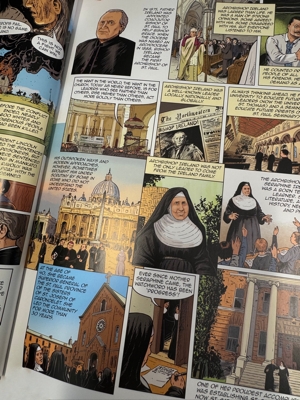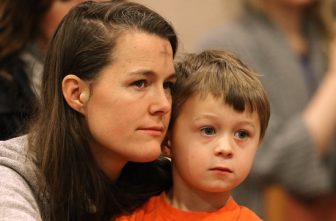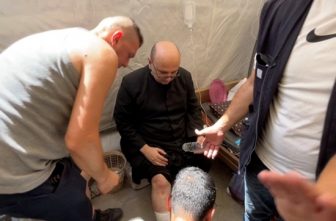
Catholics might have seen them in their parishes this summer: books with 529 pages of photographs, words and illustrations outlining the 175-year history of the Archdiocese of St. Paul and Minneapolis, and an accompanying graphic novel.

“In Everything, Give Thanks, A History of the Archdiocese of Saint Paul and Minneapolis” includes 13 chapters tracing the archdiocese’s earliest beginnings to the present day; 386 pages devoted to each of the 189 parishes in the archdiocese, eight pages on Catholic universities and regional schools, 14 pages honoring convents and monasteries, seven pages on service organizations, and a comprehensive index.
The 35-page graphic novel — plus a three-page timeline — courses through the archdiocese’s history and is titled “Catholics in the Northland, The History or the Archdiocese of Saint Paul and Minneapolis.”
“Anniversaries are privileged opportunities for counting blessings,” Archbishop Bernard Hebda writes in the introduction to the 529-page book. “In this year in which Catholics around the world are at Pope Francis’ direction marking a year of Jubilee, we in the Archdiocese are at the same time celebrating the 175th anniversary of the establishment of this local Church.”
Blessed Pope Pius IX established the creation of the Diocese of St. Paul on July 19, 1850. He named Joseph Crétin, a missionary priest from France, to be the first bishop. He led a diocese that at that time covered the Minnesota Territory, which encompassed present-day Minnesota, North Dakota and South Dakota.
“By God’s providential hand, and the hard work of dedicated clergy, zealous Religious and faithful laity, the local Church that Bishop Crétin planted has grown and flourished,” the archbishop wrote.
The books and graphic novels are available in nearly every parish; prices may vary, said Leah Heselton, operations coordinator for the archdiocese’s Office of Communications, which spearheaded the production of the book.
“This book unites the archdiocese,” Heselton said. “It helps us see that our Church is more than our local parish.”
Maternity of Mary and Holy Childhood parishes in St. Paul ordered books, asked volunteers at weekend Masses to help sell them and sold out in two weeks, said Siena Schmitz, office administrator for the parishes, which share a pastor and parish staff.
“I think a lot of people were excited to see what other parishes there are in the archdiocese,” Schmitz said, adding that she was intrigued by the many architectural styles represented among the churches.
St. Nicholas in Elko New Market honored volunteers by giving them the books May 3 at the parish’s annual appreciation dinner, said Rochelle Ibarra, the parish’s administrative assistant. Ibarra said she and Father Michael Rudolph, the pastor, and Karen Johnson, communications director and bookkeeper, brainstormed and came up with the idea.

“We had lots of compliments, with people saying it was great,” Ibarra said of the 42 volunteers who came to the dinner. Several of the volunteers were inspired to purchase books for their family members, she said. The books and the graphic novels were made available as well to people receiving their first Communion, she said.
Heselton and Tom Halden, communications director for the archdiocese, helped coordinate the two-year effort to obtain archival photos and illustrations, facts and figures. The archdiocese chose a company in France to develop the book, Editions du Signe, a major player in religious, historical, heritage and cultural publishing.
David Riehl, administrator at the French company, which his father, Christian, founded in 1987, spent six weeks in the archdiocese to help marshal photos and facts from each parish, school and other Catholic entities in the archdiocese, and a year on the layout.
Riehl was quick to credit others at his company, including Maria and Corinna Laughlin, writers who flew to Minnesota to conduct interviews and work with Allison Spies, archives program manager in the archdiocese’s Office of Archives and Records Management. Photographers Karine Faby and Patrick Bogner also worked on the project, Riehl said.
“It is very complete, you know,” Riehl said of the history provided in the book, much of which came from the archdiocese’s archives.
The first U.S. project for Editions du Signe was 35 years ago, with the late Cardinal John O’Connor in New York desiring a history of that archdiocese, Riehl said. His father visited all 400 churches, said Riehl, who is Catholic.
Riehl’s company also produced the Archdiocese of St. Paul and Minneapolis’ commemorative book for its 150th anniversary and has done work for other dioceses and Catholic organizations around the country.
Prior to founding his own company, Riehl’s father worked for a Catholic publishing firm in France. In his father’s travels through France and Germany, he began visiting parishes, dioceses and archdioceses and found many were interested in having a book about them, Riehl said.
Any recounting of history is important, Riehl said, to learn from the past, better live in the present and plan for the future.




